The Top 10 Troubled Film Productions
"The Trials and Tribulations of Filmmaking"
Fox's reboot of the
Fantastic Four is out in theaters this week. Before its release,
Fantastic Four has been a very troubled production from the outset: the production was criticized for having a young cast and casting Michael B. Jordan as Johnny Storm. 20th Century Fox's lack of promotion for the movie and embargoing reviews for the movie up to 12 hours before the movie's release sends a certain message.
Kim Masters and Borys Kit of The
Hollywood Reporter wrote an
exposé about the movie's production, focusing on the behavior of its director Josh Trank. They reported on Trank's eccentric behavior, with his lack of direction forcing producers Simon Kinberg and Hutch Parker on set, and reports that senior Fox executives had to apologize to the owner of a rent house in New Orleans after Trank trashed it. Trank was described as “one of these kids who comes to the NBA with all the talent and none of the character-based skills to handle it. There’s equipment he doesn’t yet have."
Fantastic Four underwent reshoots which proved to be a logistical nightmare because of the actors' schedules and there were rumors that Matthew Vaughn took over the reshoots to salvage the movie; Trank's conduct lead to him being removed as the director of the second
Star Wars Anthology movie.
With all this baggage in mind, we at Entertainment Fuse look at other movies that were the result of blood, sweat and tears and even that was not enough for some movies.
10. The Wizard of Oz
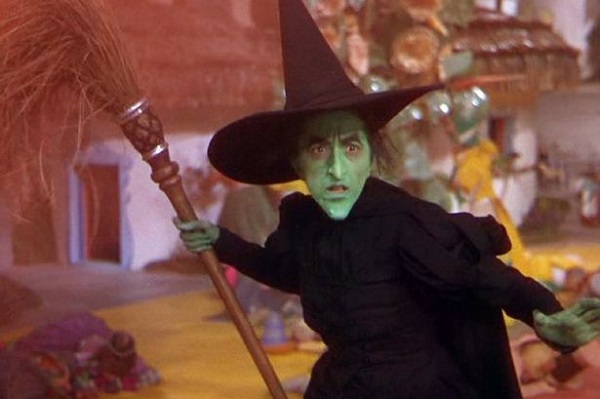 The Wizard of Oz
The Wizard of Oz is a classic family fantasy movie that is considered to be one of the best to come from the Golden Age of Hollywood. But it was a movie that went through a revolving door of writers and directors. William H. Cannon originally wrote an outline that removed the fantasy elements, making the Scarecrow to be a man so stupid that being a scarecrow is the only work he could do and The Tin Man was a heartless criminal who was encased in tin for eternity - similar to the 1925 version.
When filming finally began Richard Thorpe was on the directing duties, replacing Norman Taurog after a few Technicolor test shots. Thorpe helmed the movie for 10 days when Buddy Ebsen, the original actor cast as The Tin Man, was hospitalized due to the aluminium powder makeup getting into his lungs. Thorpe's footage did not make it into the final version of the movie.
George Cukor, Victor Fleming and King Vidor also directed
The Wizard of Oz. Cukor set the groundwork as a "creative advisor", but he and Fleming had to leave the movie to direct
Gone With the Wind.
During the scene when The Wicked Witch appears in Munchkin Town actress Margaret Hamilton ended up getting badly burned when a stunt went wrong. The makeup Hamilton was wearing was set on fire and had to be removed to avoid second degree burns and had to go to hospital for six weeks.
The original cut was two hours, but edited into the movie we know and love, after test audiences in California said the flick was too long.
9. Highlander II: The Quickening
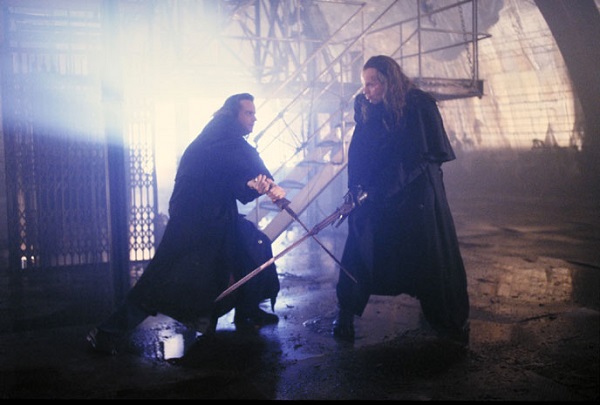
The action-fantasy
Highlander was a movie that became a cult classic and ended on a conclusive note. This did not stop some bright sparks thinking a sequel would be a good idea to continue the series: they achieve this in the dumbest way possible, retconning the origins of the immortals as aliens from the planet Zeist. What resulted was a movie considered one of the worst sequels ever made and ignored by following instalments.
Highlander II: The Quickening was filmed in Argentina, picked as a location because the US dollar was strong against the Peso. But Argentina lacked skilled workers in the industry and crew members from the UK were flown in, leading to a hostile set because of remaining animosity over the Falkland Wars. The value of the Peso fluctuated leading to the budget of the movie going out of control and the bonding company taking over the production, making a movie that they thought would be the most marketable.
Director Russell Mulcahy tried to have his name removed from the pseudonym Alan Smithee, but the producers threatened to sue him if he did that. Mulcahy walked out of the premier after 15 minutes and his career has been dented ever since.
The movie has subsequently been reedited to remove all references that the Immortals were aliens.
8. Cleopatra

The historical epic
Cleopatra was the first movie to be the highest grossing movie in the year of its release that still failed to make a profit. It made $26 million domestically from a $44 million budget. It ended up being the most expensive movie ever made when inflation is counted, costing $338.94 million in today's money.
Cleopatra was originally set to have a $2 million budget, but it quickly ballooned into a monstrous amount and nearly bankrupted 20th Century Fox. Rouben Mamoulian was originally set to direct and was replaced by Joseph L. Mankiewicz. Star Elizabeth Taylor became ill during the shoot, requiring a tracheotomy to save her life. The shoot was forced to move from London to Rome due to Taylor's health, resulting in a huge cost transferring all the sets and costumes. Due to the length of time of the shoot Taylor's fee rose from $1 Million to $7 Million ($53.9 Million today). Taylor and Richard Burton brought controversy to the movie when they had their famous affair and became the center of media attention. Mankiewicz also had to face a different filming culture in Italy and constantly had to demand silences from the artisans.
Even when filming was completed Mankiewicz battled with Fox over the length of the movie. Mankiewicz produced a six hour cut but Fox halved it to three, but it required reshoots to fill in the gaps.
The troubled production ended up being the final nail for Hollywood epics and sword-and-sandal movies.
7. Heaven's Gate
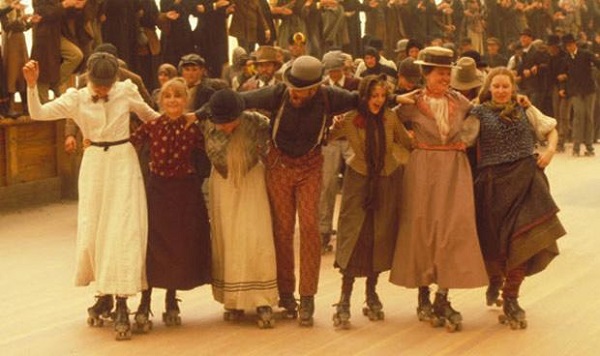
The Western epic
Heaven's Gate serves as a warning against directional hubris and a movie that had negative effects on the film industry. After
The Deer Hunter won Oscars for Best Picture and Best Director, Michael Cimino became one of the most in demand directors in Hollywood and he was allowed carte blanche for his dream project. It quickly turned into a nightmare.
Heaven's Gate went over budget and it has been described as being five days behind schedule after the sixth day.
Cimino's ego ran rampant during the shoot, he took 50 takes to film individual scenes, he had a street set build to his precise specifications and had it torn down when he said it did not look right. He also delayed shooting a scene so a specific cloud would come into the shot. Privately, Cimino wanted to surpass the amount of film that
Apocalypse Now was shot on, using over million feet of film.
Animal abuse was also an issue during the filming. Four horses were killed during a battle scene and many more were injected. One horse was blown up with dynamite and another was bled alive so its blood could be used. Horse and cow organs were used for the movie's more gory moments, real cock fights were filmed and there have been accusations of chickens being decapitated. Two Medicine Lake was polluted with oil due to the construction of the sets.
When the shoot was completed Cimino changed the locks on the editing suite to prevent studio interference. The move nearly got him fired.
Heaven's Gate became a box-office and critical flop. The disaster led United Artists to declare bankruptcy and the movie ended the New Hollywood movement, resulting in studios turning away from director-driven movies.
6. Super Mario Bros.
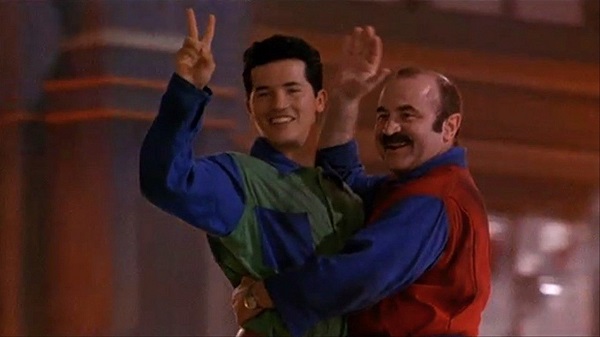 Super Mario Bros.
Super Mario Bros. was the first Hollywood live-action adaptation of a video game and it set the unfortunate precedent of most video game movies sucking. The
Super Mario Bros. was originally set out to be a light-hearted fantasy comedy for families and many of the actors signed on to the project with that intention. The movie mutated into the monster we know when the inexperienced directing duo Rocky Morton and Annabel Jankel were handed the reins and deviated heavily from the source material, turning it into an adult-orientated
Blade Runner-esque sci-fi movie.
When Morton and Jankel directed
Super Mario Bros. they quickly went over budget and behind schedule. Most of the cast and crew hated the husband and wife team because of their mismanagement and the movie was constantly re-written during filming. Bob Hoskins described it as the worst film he ever worked on and came up with some very unpleasant names for the directors. John Leguizamo said in his autobiography that he and Hoskins became friends because of their hatred for the movie and they had to get drunk to make it through the filming.
Morton and Jankel were fired from
Super Mario Bros., their own agent even told them to get off the set and director of photography Dean Semler had to finish the movie. It was critical and commercial flop and the directorial team struggled to find work afterwards. Nintendo have been reluctant to allow Western companies to adapt their properties since the flop.
5. Waterworld
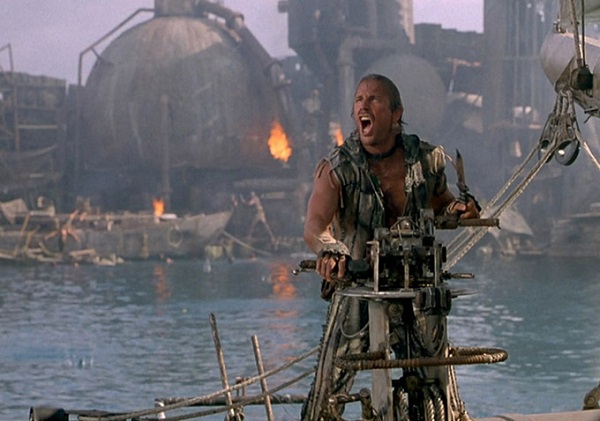
Back in 1995
Waterworld became a source of ridicule when it became the most expensive movie made at the time, having a budget of $172 million ($235 when marketing and distribution is included). The budget spiralled out of control due to the movie being a very difficult shoot. The troubled production was parodied twice in
The Simpsons.
Waterworld has been described as
Mad Max on water which is the first sign of why the movie was a troubled shoot because filming on water is notoriously difficult. The shoot took 157 days, made even more difficult when the set collapsed after a hurricane and hurricane alerts shut down the production three times. Stunt coordinator Norman Howell ended up getting compression sickness and had to be treated in hospital and surfer/stuntman Laird Hamilton became lost at sea when his jet ski ran out of fuel (fortunately he is alive and well). Kevin Costner was also nearly killed during one stunt when he was tied to the mast of his trimaran.
Costner's ego was another factor as to why the movie was a troubled production with crewmembers being resentful that the star stayed in luxury while the rest of them had to stay in overheated, inadequate accommodation. Joss Whedon was brought in to do on set for rewrites to incorporate Costner's ideas into the script. Whedon described the experience as "seven weeks of hell". Director Kevin Reynolds left the project, leaving Costner to complete the movie. Reyonlds is quoted saying this about Costner: "Kevin should only star in movies he directs. That way he can work with his favorite actor and favorite director".
4. The Man Who Killed Don Quixote
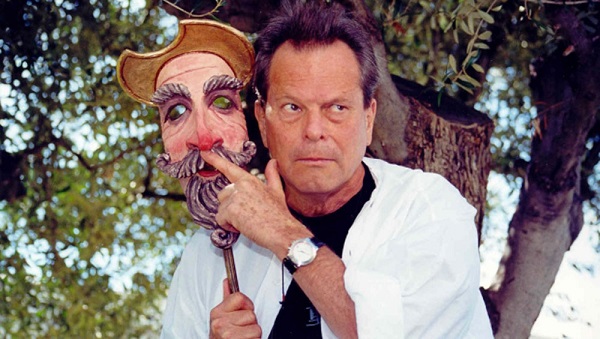
Monty Python alumni and filmmaking legend Terry Gilliam has faced many production problems during his career. He had to rework
The Imaginarium of Doctor Parnassus after Heath Ledger's death and his planned adaptations of
Watchmen and
A Tale of Two Cities never made it out of pre-production: but it was the adaptation of
The Man Who Killed Don Quixote that defeated Gilliam.
The Man Who Killed Don Quixote was originally set to star Jean Rochefort and Johnny Depp and filming became very difficult from the outset. On the second day of the shoot a flash flood damaged equipment and changed the physical landscape of the shoot, making all footage filmed on the first day useless. When Rochefort attempted to ride a horse it became clear he was injured, having a slipped disc and unable to continue. Filming was cancelled and it resulted with a $15 Million insurance claim. The troubled shoot became the subject of the 2002 documentary
Lost in La Mancha.
After many years of trying to restart the movie
The Man Who Killed Don Quixote is set to start filming soon with John Hurt and Jack O'Connell in the lead roles.
3. Roar
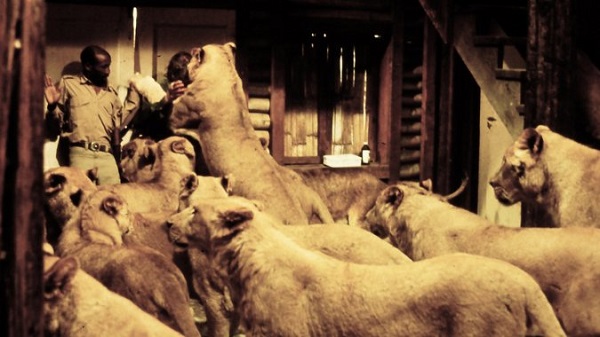
1981's
Roar was American-South African co-production that has been deemed as one of the most dangerous film shoots ever due to the fact it had on set 110 untrained lions, tigers, leopards, jaguars and cheetahs and two elephants were used. Many of the animals being rejected by zoos and circuses. Then married couple Tippi Hedren and Noel Marshall starred in and produced this thriller with Marshall also taking on writing and directing duties. They kept the animals on their range in California as they told the story of a family being held under siege by the magnificent beasts.
Roar took five years to film. Over 70 members of the crew were injured during filming and the movie had a high turnaround of crew because of the conditions. Cinematographer Jan de Bont who ended up directing
Speed, received 220 stitches and Marshall got gangrene due to puncture wounds. Hedren got a fractured leg and is quoted to say "This was probably the most dangerous film that Hollywood has ever seen. It's amazing no was killed." Hedren's daughter, Melanie Griffith was mauled by a lion and required plastic surgery and assistant director Doron Kauper was nearly killed after being mauled by a lion. All the animal attacks in the movie are genuine attacks, not staged.
Although no people lost their lives, several lions were killed in 1978 after a dam broke and Marshall was attacked by a cheetah when trying to protect the animal from a wildfire.
Roar cost $17 Million to make and it only made $2 Million at the box office, but it has been re-released in April 2015.
2. Midnight Rider
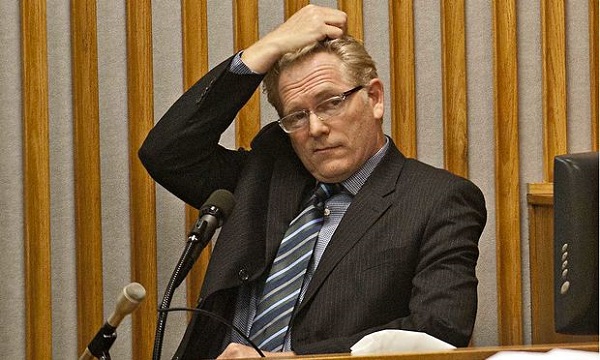 Midnight Rider
Midnight Rider was a planned independent biopic about musician Gregg Allman with William Hurt set to star. The production gained notoriety after the death of Sarah Jones, the second camera assistant, after being struck by a train when filming on an active railroad track. The incident also saw seven other crew members being injured. Jones' death had massive repercussions, workers in the film industry went online to complain about other shoots where safety was treated with a cavalier attitude and Jones being remembered at the 86th Academy Awards.
Hurt pulled out from the project and prosecutions were brought against director Randall Miller, producer Jody Savin, executive producer Jay Sedrish and first assistant director Hillary Schwartz. Miller plead guilty to involuntary manslaughter and criminal trespass and was sentenced to 10 years, two in prison followed by probation. Sedrish and Schwartz both received 10 years probation and a fine while charges against Savin were dropped. Jones' family are currently filing a civil lawsuit.
1. Apocalypse Now
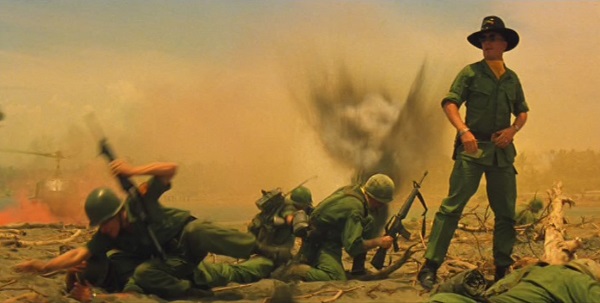
Not all movies that were troubled productions ended up being disasters and
Apocalypse Now is testament to that, being considered one of the greatest war movies ever made.
Apocalypse Now was a long, arduous shoot: it was set to last six weeks, but ended up taking 16 months. Harvey Keitel was originally set to star as Captain Willard but was replaced by Martin Sheen because Francis Ford Coppola disliked Keitel's performance. While filming, Sheen had a heart attack and was out of action for five weeks. Coppola's
The Godfather star Marlon Brando was cast as Colonel Kurtz, but was incredibly out of shape, resulting in Coppola filming the notorious actor in shadows. Brando also refused to read the script or even read
Heart of Darkness and insisted he improvise his own lines, clashing with Coppola in the process.
As well as issues with the actors, the shoot had been hampered by the weather, including a typhoon which destroyed sets. The Filipino government lent the shoot some of their army helicopters but the government were fighting rebels and they had to be called to battle.
Apocalypse Now went over budget and Coppola ended up having to self-finance the movie, remortgaging his home and vineyard and threatened to commit suicide during the shoot. After the shoot was committed
Apocalypse Now was still troublesome because it took three years to edit.
 The Wizard of Oz is a classic family fantasy movie that is considered to be one of the best to come from the Golden Age of Hollywood. But it was a movie that went through a revolving door of writers and directors. William H. Cannon originally wrote an outline that removed the fantasy elements, making the Scarecrow to be a man so stupid that being a scarecrow is the only work he could do and The Tin Man was a heartless criminal who was encased in tin for eternity - similar to the 1925 version.
When filming finally began Richard Thorpe was on the directing duties, replacing Norman Taurog after a few Technicolor test shots. Thorpe helmed the movie for 10 days when Buddy Ebsen, the original actor cast as The Tin Man, was hospitalized due to the aluminium powder makeup getting into his lungs. Thorpe's footage did not make it into the final version of the movie.
George Cukor, Victor Fleming and King Vidor also directed The Wizard of Oz. Cukor set the groundwork as a "creative advisor", but he and Fleming had to leave the movie to direct Gone With the Wind.
During the scene when The Wicked Witch appears in Munchkin Town actress Margaret Hamilton ended up getting badly burned when a stunt went wrong. The makeup Hamilton was wearing was set on fire and had to be removed to avoid second degree burns and had to go to hospital for six weeks.
The original cut was two hours, but edited into the movie we know and love, after test audiences in California said the flick was too long.
9. Highlander II: The Quickening
The Wizard of Oz is a classic family fantasy movie that is considered to be one of the best to come from the Golden Age of Hollywood. But it was a movie that went through a revolving door of writers and directors. William H. Cannon originally wrote an outline that removed the fantasy elements, making the Scarecrow to be a man so stupid that being a scarecrow is the only work he could do and The Tin Man was a heartless criminal who was encased in tin for eternity - similar to the 1925 version.
When filming finally began Richard Thorpe was on the directing duties, replacing Norman Taurog after a few Technicolor test shots. Thorpe helmed the movie for 10 days when Buddy Ebsen, the original actor cast as The Tin Man, was hospitalized due to the aluminium powder makeup getting into his lungs. Thorpe's footage did not make it into the final version of the movie.
George Cukor, Victor Fleming and King Vidor also directed The Wizard of Oz. Cukor set the groundwork as a "creative advisor", but he and Fleming had to leave the movie to direct Gone With the Wind.
During the scene when The Wicked Witch appears in Munchkin Town actress Margaret Hamilton ended up getting badly burned when a stunt went wrong. The makeup Hamilton was wearing was set on fire and had to be removed to avoid second degree burns and had to go to hospital for six weeks.
The original cut was two hours, but edited into the movie we know and love, after test audiences in California said the flick was too long.
9. Highlander II: The Quickening
 The action-fantasy Highlander was a movie that became a cult classic and ended on a conclusive note. This did not stop some bright sparks thinking a sequel would be a good idea to continue the series: they achieve this in the dumbest way possible, retconning the origins of the immortals as aliens from the planet Zeist. What resulted was a movie considered one of the worst sequels ever made and ignored by following instalments.
Highlander II: The Quickening was filmed in Argentina, picked as a location because the US dollar was strong against the Peso. But Argentina lacked skilled workers in the industry and crew members from the UK were flown in, leading to a hostile set because of remaining animosity over the Falkland Wars. The value of the Peso fluctuated leading to the budget of the movie going out of control and the bonding company taking over the production, making a movie that they thought would be the most marketable.
Director Russell Mulcahy tried to have his name removed from the pseudonym Alan Smithee, but the producers threatened to sue him if he did that. Mulcahy walked out of the premier after 15 minutes and his career has been dented ever since.
The movie has subsequently been reedited to remove all references that the Immortals were aliens.
8. Cleopatra
The action-fantasy Highlander was a movie that became a cult classic and ended on a conclusive note. This did not stop some bright sparks thinking a sequel would be a good idea to continue the series: they achieve this in the dumbest way possible, retconning the origins of the immortals as aliens from the planet Zeist. What resulted was a movie considered one of the worst sequels ever made and ignored by following instalments.
Highlander II: The Quickening was filmed in Argentina, picked as a location because the US dollar was strong against the Peso. But Argentina lacked skilled workers in the industry and crew members from the UK were flown in, leading to a hostile set because of remaining animosity over the Falkland Wars. The value of the Peso fluctuated leading to the budget of the movie going out of control and the bonding company taking over the production, making a movie that they thought would be the most marketable.
Director Russell Mulcahy tried to have his name removed from the pseudonym Alan Smithee, but the producers threatened to sue him if he did that. Mulcahy walked out of the premier after 15 minutes and his career has been dented ever since.
The movie has subsequently been reedited to remove all references that the Immortals were aliens.
8. Cleopatra
 The historical epic Cleopatra was the first movie to be the highest grossing movie in the year of its release that still failed to make a profit. It made $26 million domestically from a $44 million budget. It ended up being the most expensive movie ever made when inflation is counted, costing $338.94 million in today's money.
Cleopatra was originally set to have a $2 million budget, but it quickly ballooned into a monstrous amount and nearly bankrupted 20th Century Fox. Rouben Mamoulian was originally set to direct and was replaced by Joseph L. Mankiewicz. Star Elizabeth Taylor became ill during the shoot, requiring a tracheotomy to save her life. The shoot was forced to move from London to Rome due to Taylor's health, resulting in a huge cost transferring all the sets and costumes. Due to the length of time of the shoot Taylor's fee rose from $1 Million to $7 Million ($53.9 Million today). Taylor and Richard Burton brought controversy to the movie when they had their famous affair and became the center of media attention. Mankiewicz also had to face a different filming culture in Italy and constantly had to demand silences from the artisans.
Even when filming was completed Mankiewicz battled with Fox over the length of the movie. Mankiewicz produced a six hour cut but Fox halved it to three, but it required reshoots to fill in the gaps.
The troubled production ended up being the final nail for Hollywood epics and sword-and-sandal movies.
7. Heaven's Gate
The historical epic Cleopatra was the first movie to be the highest grossing movie in the year of its release that still failed to make a profit. It made $26 million domestically from a $44 million budget. It ended up being the most expensive movie ever made when inflation is counted, costing $338.94 million in today's money.
Cleopatra was originally set to have a $2 million budget, but it quickly ballooned into a monstrous amount and nearly bankrupted 20th Century Fox. Rouben Mamoulian was originally set to direct and was replaced by Joseph L. Mankiewicz. Star Elizabeth Taylor became ill during the shoot, requiring a tracheotomy to save her life. The shoot was forced to move from London to Rome due to Taylor's health, resulting in a huge cost transferring all the sets and costumes. Due to the length of time of the shoot Taylor's fee rose from $1 Million to $7 Million ($53.9 Million today). Taylor and Richard Burton brought controversy to the movie when they had their famous affair and became the center of media attention. Mankiewicz also had to face a different filming culture in Italy and constantly had to demand silences from the artisans.
Even when filming was completed Mankiewicz battled with Fox over the length of the movie. Mankiewicz produced a six hour cut but Fox halved it to three, but it required reshoots to fill in the gaps.
The troubled production ended up being the final nail for Hollywood epics and sword-and-sandal movies.
7. Heaven's Gate
 The Western epic Heaven's Gate serves as a warning against directional hubris and a movie that had negative effects on the film industry. After The Deer Hunter won Oscars for Best Picture and Best Director, Michael Cimino became one of the most in demand directors in Hollywood and he was allowed carte blanche for his dream project. It quickly turned into a nightmare. Heaven's Gate went over budget and it has been described as being five days behind schedule after the sixth day.
Cimino's ego ran rampant during the shoot, he took 50 takes to film individual scenes, he had a street set build to his precise specifications and had it torn down when he said it did not look right. He also delayed shooting a scene so a specific cloud would come into the shot. Privately, Cimino wanted to surpass the amount of film that Apocalypse Now was shot on, using over million feet of film.
Animal abuse was also an issue during the filming. Four horses were killed during a battle scene and many more were injected. One horse was blown up with dynamite and another was bled alive so its blood could be used. Horse and cow organs were used for the movie's more gory moments, real cock fights were filmed and there have been accusations of chickens being decapitated. Two Medicine Lake was polluted with oil due to the construction of the sets.
When the shoot was completed Cimino changed the locks on the editing suite to prevent studio interference. The move nearly got him fired.
Heaven's Gate became a box-office and critical flop. The disaster led United Artists to declare bankruptcy and the movie ended the New Hollywood movement, resulting in studios turning away from director-driven movies.
6. Super Mario Bros.
The Western epic Heaven's Gate serves as a warning against directional hubris and a movie that had negative effects on the film industry. After The Deer Hunter won Oscars for Best Picture and Best Director, Michael Cimino became one of the most in demand directors in Hollywood and he was allowed carte blanche for his dream project. It quickly turned into a nightmare. Heaven's Gate went over budget and it has been described as being five days behind schedule after the sixth day.
Cimino's ego ran rampant during the shoot, he took 50 takes to film individual scenes, he had a street set build to his precise specifications and had it torn down when he said it did not look right. He also delayed shooting a scene so a specific cloud would come into the shot. Privately, Cimino wanted to surpass the amount of film that Apocalypse Now was shot on, using over million feet of film.
Animal abuse was also an issue during the filming. Four horses were killed during a battle scene and many more were injected. One horse was blown up with dynamite and another was bled alive so its blood could be used. Horse and cow organs were used for the movie's more gory moments, real cock fights were filmed and there have been accusations of chickens being decapitated. Two Medicine Lake was polluted with oil due to the construction of the sets.
When the shoot was completed Cimino changed the locks on the editing suite to prevent studio interference. The move nearly got him fired.
Heaven's Gate became a box-office and critical flop. The disaster led United Artists to declare bankruptcy and the movie ended the New Hollywood movement, resulting in studios turning away from director-driven movies.
6. Super Mario Bros.
 Super Mario Bros. was the first Hollywood live-action adaptation of a video game and it set the unfortunate precedent of most video game movies sucking. The Super Mario Bros. was originally set out to be a light-hearted fantasy comedy for families and many of the actors signed on to the project with that intention. The movie mutated into the monster we know when the inexperienced directing duo Rocky Morton and Annabel Jankel were handed the reins and deviated heavily from the source material, turning it into an adult-orientated Blade Runner-esque sci-fi movie.
When Morton and Jankel directed Super Mario Bros. they quickly went over budget and behind schedule. Most of the cast and crew hated the husband and wife team because of their mismanagement and the movie was constantly re-written during filming. Bob Hoskins described it as the worst film he ever worked on and came up with some very unpleasant names for the directors. John Leguizamo said in his autobiography that he and Hoskins became friends because of their hatred for the movie and they had to get drunk to make it through the filming.
Morton and Jankel were fired from Super Mario Bros., their own agent even told them to get off the set and director of photography Dean Semler had to finish the movie. It was critical and commercial flop and the directorial team struggled to find work afterwards. Nintendo have been reluctant to allow Western companies to adapt their properties since the flop.
5. Waterworld
Super Mario Bros. was the first Hollywood live-action adaptation of a video game and it set the unfortunate precedent of most video game movies sucking. The Super Mario Bros. was originally set out to be a light-hearted fantasy comedy for families and many of the actors signed on to the project with that intention. The movie mutated into the monster we know when the inexperienced directing duo Rocky Morton and Annabel Jankel were handed the reins and deviated heavily from the source material, turning it into an adult-orientated Blade Runner-esque sci-fi movie.
When Morton and Jankel directed Super Mario Bros. they quickly went over budget and behind schedule. Most of the cast and crew hated the husband and wife team because of their mismanagement and the movie was constantly re-written during filming. Bob Hoskins described it as the worst film he ever worked on and came up with some very unpleasant names for the directors. John Leguizamo said in his autobiography that he and Hoskins became friends because of their hatred for the movie and they had to get drunk to make it through the filming.
Morton and Jankel were fired from Super Mario Bros., their own agent even told them to get off the set and director of photography Dean Semler had to finish the movie. It was critical and commercial flop and the directorial team struggled to find work afterwards. Nintendo have been reluctant to allow Western companies to adapt their properties since the flop.
5. Waterworld
 Back in 1995 Waterworld became a source of ridicule when it became the most expensive movie made at the time, having a budget of $172 million ($235 when marketing and distribution is included). The budget spiralled out of control due to the movie being a very difficult shoot. The troubled production was parodied twice in The Simpsons.
Waterworld has been described as Mad Max on water which is the first sign of why the movie was a troubled shoot because filming on water is notoriously difficult. The shoot took 157 days, made even more difficult when the set collapsed after a hurricane and hurricane alerts shut down the production three times. Stunt coordinator Norman Howell ended up getting compression sickness and had to be treated in hospital and surfer/stuntman Laird Hamilton became lost at sea when his jet ski ran out of fuel (fortunately he is alive and well). Kevin Costner was also nearly killed during one stunt when he was tied to the mast of his trimaran.
Costner's ego was another factor as to why the movie was a troubled production with crewmembers being resentful that the star stayed in luxury while the rest of them had to stay in overheated, inadequate accommodation. Joss Whedon was brought in to do on set for rewrites to incorporate Costner's ideas into the script. Whedon described the experience as "seven weeks of hell". Director Kevin Reynolds left the project, leaving Costner to complete the movie. Reyonlds is quoted saying this about Costner: "Kevin should only star in movies he directs. That way he can work with his favorite actor and favorite director".
4. The Man Who Killed Don Quixote
Back in 1995 Waterworld became a source of ridicule when it became the most expensive movie made at the time, having a budget of $172 million ($235 when marketing and distribution is included). The budget spiralled out of control due to the movie being a very difficult shoot. The troubled production was parodied twice in The Simpsons.
Waterworld has been described as Mad Max on water which is the first sign of why the movie was a troubled shoot because filming on water is notoriously difficult. The shoot took 157 days, made even more difficult when the set collapsed after a hurricane and hurricane alerts shut down the production three times. Stunt coordinator Norman Howell ended up getting compression sickness and had to be treated in hospital and surfer/stuntman Laird Hamilton became lost at sea when his jet ski ran out of fuel (fortunately he is alive and well). Kevin Costner was also nearly killed during one stunt when he was tied to the mast of his trimaran.
Costner's ego was another factor as to why the movie was a troubled production with crewmembers being resentful that the star stayed in luxury while the rest of them had to stay in overheated, inadequate accommodation. Joss Whedon was brought in to do on set for rewrites to incorporate Costner's ideas into the script. Whedon described the experience as "seven weeks of hell". Director Kevin Reynolds left the project, leaving Costner to complete the movie. Reyonlds is quoted saying this about Costner: "Kevin should only star in movies he directs. That way he can work with his favorite actor and favorite director".
4. The Man Who Killed Don Quixote
 Monty Python alumni and filmmaking legend Terry Gilliam has faced many production problems during his career. He had to rework The Imaginarium of Doctor Parnassus after Heath Ledger's death and his planned adaptations of Watchmen and A Tale of Two Cities never made it out of pre-production: but it was the adaptation of The Man Who Killed Don Quixote that defeated Gilliam.
The Man Who Killed Don Quixote was originally set to star Jean Rochefort and Johnny Depp and filming became very difficult from the outset. On the second day of the shoot a flash flood damaged equipment and changed the physical landscape of the shoot, making all footage filmed on the first day useless. When Rochefort attempted to ride a horse it became clear he was injured, having a slipped disc and unable to continue. Filming was cancelled and it resulted with a $15 Million insurance claim. The troubled shoot became the subject of the 2002 documentary Lost in La Mancha.
After many years of trying to restart the movie The Man Who Killed Don Quixote is set to start filming soon with John Hurt and Jack O'Connell in the lead roles.
3. Roar
Monty Python alumni and filmmaking legend Terry Gilliam has faced many production problems during his career. He had to rework The Imaginarium of Doctor Parnassus after Heath Ledger's death and his planned adaptations of Watchmen and A Tale of Two Cities never made it out of pre-production: but it was the adaptation of The Man Who Killed Don Quixote that defeated Gilliam.
The Man Who Killed Don Quixote was originally set to star Jean Rochefort and Johnny Depp and filming became very difficult from the outset. On the second day of the shoot a flash flood damaged equipment and changed the physical landscape of the shoot, making all footage filmed on the first day useless. When Rochefort attempted to ride a horse it became clear he was injured, having a slipped disc and unable to continue. Filming was cancelled and it resulted with a $15 Million insurance claim. The troubled shoot became the subject of the 2002 documentary Lost in La Mancha.
After many years of trying to restart the movie The Man Who Killed Don Quixote is set to start filming soon with John Hurt and Jack O'Connell in the lead roles.
3. Roar
 1981's Roar was American-South African co-production that has been deemed as one of the most dangerous film shoots ever due to the fact it had on set 110 untrained lions, tigers, leopards, jaguars and cheetahs and two elephants were used. Many of the animals being rejected by zoos and circuses. Then married couple Tippi Hedren and Noel Marshall starred in and produced this thriller with Marshall also taking on writing and directing duties. They kept the animals on their range in California as they told the story of a family being held under siege by the magnificent beasts.
Roar took five years to film. Over 70 members of the crew were injured during filming and the movie had a high turnaround of crew because of the conditions. Cinematographer Jan de Bont who ended up directing Speed, received 220 stitches and Marshall got gangrene due to puncture wounds. Hedren got a fractured leg and is quoted to say "This was probably the most dangerous film that Hollywood has ever seen. It's amazing no was killed." Hedren's daughter, Melanie Griffith was mauled by a lion and required plastic surgery and assistant director Doron Kauper was nearly killed after being mauled by a lion. All the animal attacks in the movie are genuine attacks, not staged.
Although no people lost their lives, several lions were killed in 1978 after a dam broke and Marshall was attacked by a cheetah when trying to protect the animal from a wildfire.
Roar cost $17 Million to make and it only made $2 Million at the box office, but it has been re-released in April 2015.
2. Midnight Rider
1981's Roar was American-South African co-production that has been deemed as one of the most dangerous film shoots ever due to the fact it had on set 110 untrained lions, tigers, leopards, jaguars and cheetahs and two elephants were used. Many of the animals being rejected by zoos and circuses. Then married couple Tippi Hedren and Noel Marshall starred in and produced this thriller with Marshall also taking on writing and directing duties. They kept the animals on their range in California as they told the story of a family being held under siege by the magnificent beasts.
Roar took five years to film. Over 70 members of the crew were injured during filming and the movie had a high turnaround of crew because of the conditions. Cinematographer Jan de Bont who ended up directing Speed, received 220 stitches and Marshall got gangrene due to puncture wounds. Hedren got a fractured leg and is quoted to say "This was probably the most dangerous film that Hollywood has ever seen. It's amazing no was killed." Hedren's daughter, Melanie Griffith was mauled by a lion and required plastic surgery and assistant director Doron Kauper was nearly killed after being mauled by a lion. All the animal attacks in the movie are genuine attacks, not staged.
Although no people lost their lives, several lions were killed in 1978 after a dam broke and Marshall was attacked by a cheetah when trying to protect the animal from a wildfire.
Roar cost $17 Million to make and it only made $2 Million at the box office, but it has been re-released in April 2015.
2. Midnight Rider
 Midnight Rider was a planned independent biopic about musician Gregg Allman with William Hurt set to star. The production gained notoriety after the death of Sarah Jones, the second camera assistant, after being struck by a train when filming on an active railroad track. The incident also saw seven other crew members being injured. Jones' death had massive repercussions, workers in the film industry went online to complain about other shoots where safety was treated with a cavalier attitude and Jones being remembered at the 86th Academy Awards.
Hurt pulled out from the project and prosecutions were brought against director Randall Miller, producer Jody Savin, executive producer Jay Sedrish and first assistant director Hillary Schwartz. Miller plead guilty to involuntary manslaughter and criminal trespass and was sentenced to 10 years, two in prison followed by probation. Sedrish and Schwartz both received 10 years probation and a fine while charges against Savin were dropped. Jones' family are currently filing a civil lawsuit.
1. Apocalypse Now
Midnight Rider was a planned independent biopic about musician Gregg Allman with William Hurt set to star. The production gained notoriety after the death of Sarah Jones, the second camera assistant, after being struck by a train when filming on an active railroad track. The incident also saw seven other crew members being injured. Jones' death had massive repercussions, workers in the film industry went online to complain about other shoots where safety was treated with a cavalier attitude and Jones being remembered at the 86th Academy Awards.
Hurt pulled out from the project and prosecutions were brought against director Randall Miller, producer Jody Savin, executive producer Jay Sedrish and first assistant director Hillary Schwartz. Miller plead guilty to involuntary manslaughter and criminal trespass and was sentenced to 10 years, two in prison followed by probation. Sedrish and Schwartz both received 10 years probation and a fine while charges against Savin were dropped. Jones' family are currently filing a civil lawsuit.
1. Apocalypse Now
 Not all movies that were troubled productions ended up being disasters and Apocalypse Now is testament to that, being considered one of the greatest war movies ever made.
Apocalypse Now was a long, arduous shoot: it was set to last six weeks, but ended up taking 16 months. Harvey Keitel was originally set to star as Captain Willard but was replaced by Martin Sheen because Francis Ford Coppola disliked Keitel's performance. While filming, Sheen had a heart attack and was out of action for five weeks. Coppola's The Godfather star Marlon Brando was cast as Colonel Kurtz, but was incredibly out of shape, resulting in Coppola filming the notorious actor in shadows. Brando also refused to read the script or even read Heart of Darkness and insisted he improvise his own lines, clashing with Coppola in the process.
As well as issues with the actors, the shoot had been hampered by the weather, including a typhoon which destroyed sets. The Filipino government lent the shoot some of their army helicopters but the government were fighting rebels and they had to be called to battle.
Apocalypse Now went over budget and Coppola ended up having to self-finance the movie, remortgaging his home and vineyard and threatened to commit suicide during the shoot. After the shoot was committed Apocalypse Now was still troublesome because it took three years to edit.
Not all movies that were troubled productions ended up being disasters and Apocalypse Now is testament to that, being considered one of the greatest war movies ever made.
Apocalypse Now was a long, arduous shoot: it was set to last six weeks, but ended up taking 16 months. Harvey Keitel was originally set to star as Captain Willard but was replaced by Martin Sheen because Francis Ford Coppola disliked Keitel's performance. While filming, Sheen had a heart attack and was out of action for five weeks. Coppola's The Godfather star Marlon Brando was cast as Colonel Kurtz, but was incredibly out of shape, resulting in Coppola filming the notorious actor in shadows. Brando also refused to read the script or even read Heart of Darkness and insisted he improvise his own lines, clashing with Coppola in the process.
As well as issues with the actors, the shoot had been hampered by the weather, including a typhoon which destroyed sets. The Filipino government lent the shoot some of their army helicopters but the government were fighting rebels and they had to be called to battle.
Apocalypse Now went over budget and Coppola ended up having to self-finance the movie, remortgaging his home and vineyard and threatened to commit suicide during the shoot. After the shoot was committed Apocalypse Now was still troublesome because it took three years to edit.